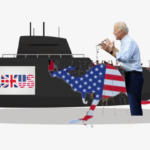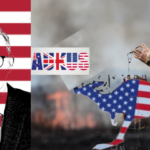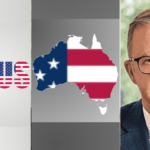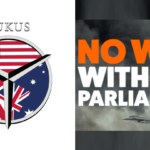AUKUS 2.0: Albanese Drives It Like He Stole It, and Then Gives It Away to the US
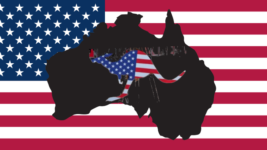
On his jaunt to the US last week, not only did defence minister Richard Marles glorify the US presence across the entire Australian military domain at the AUSMIN, but he also signed an updated version of the AUKUS Exchange of Naval Nuclear Propulsion Information Agreement (ENNPIA).
Then in announcing the updated AUKUS agreement had been tabled on Monday, Marles explained that it “will be central to Australia’s acquisition of a sovereign nuclear-powered submarine (SSN) capability from the 2030s”, including US-made SSN and UK-assisted Australian-made SSN.
“It will also enable Australia to prepare for Submarine Rotational Force-West (SRF-West) at HMAS Stirling from 2027, supporting the rotational presence of up to four Virginia class submarines from the US and one Astute class submarine from the UK,” the deputy PM added in his press release.
Yet, while Marle’s first proposition, that Australia will ever acquire any of the eight proposed SSN of its own, has been shown to be full of holes, a recent paper by the US congress’ thinktank reveals that the mainly US submarine force stationed in WA is a given and it recommends no Australian SSN.
And despite these questions, the Albanese government did table the updated EENPIA, which, if all parties provide a note assuring that domestic requirements are completed, will replace the 2022 original agreement, and this rather lopsided treaty will continue to be in force until the end of 2075.
A lack of sovereignty
The AUKUS ENNPIA establishes a legally-binding framework to facilitate the communication and exchange of naval nuclear propulsion information and nuclear material and equipment from the UK and the US to Australia – the AUKUS powers – in regard to our own coming “sovereign” SSN.
The reason it’s questionable that any boats we may acquire will be sovereign is that the deal adheres to the Treaty on the Non-Proliferation of Nuclear Weapons (NPT), which guards against new states acquiring the ability to produce such weapons, so therefore, the reactors in the subs are off-limits.
The plan is to purchase three to five second-hand Virginia class SSN from the states, starting in the early 1930s, with sealed nuclear reactors in them, and in terms of the five Australian-made AUKUS subs, the UK will provide welded naval nuclear propulsion plants to be inserted into the AUKUS SSN.
And author of Nuked, investigative journalist Andrew Fowler told the ABC last month in reference to the Virginia class SSN that if Australia buys these boats, it’s questionable that they can every really be referred to as owned solely by the nation, as treaty obligations guard against that final step.
Non-proliferation requirements
The updated ENNPIA further requires Australia to establish an Article 14 Arrangement under the Agreement between Australia and the International Atomic Energy Agency (IAEA) for the Application of Safeguards in Connection with the Treaty on the Non-Proliferation of Nuclear Weapons.
This 1974 agreement permits Australia to use nuclear material in relation to “peaceful” activities, which is safeguarded under its provisions, and this further entails ensuring that the “material is not diverted to nuclear weapons or other nuclear explosive devices”.
Article 14 of the agreement requires that if Australia plans to use nuclear material in a “non-proscribed military activity”, that our nation and the IAEA must come to an arrangement, so that Australia is permitted to use it in this non-safeguarded manner.
And if Australia is found to be in breach of the NPT, it’s agreement with the IAEA or the Article 14 agreement, the US and the UK have the right to cease the AUKUS agreement and will require the return of all nuclear material and equipment transferred to it, which again raises sovereignty.
Pulling the plug
Australians have been told that the nation is committing at least $368 billion to this AUKUS sub deal, which certainly signals a nation sliding towards a war economy with less social services. And the ENNPIA notes that no public consultation has been undertaken because the process is classified.
But as Greens Senator David Shoebridge told Sydney Criminal Lawyers in April, our nation has already committed AU$4.6 billion to the US for its nuclear submarine industrial base, and another AU$4.6 billion for the UK’s nuclear submarine industrial base.
The updated ENNPIA further provides that “any party may, by giving at least one year’s written notice to the other parties, terminate this agreement”. Yet, there is nothing within it stipulating that Australia will be receiving any refunds on these already progressing investments.
And on such termination or if one party has breached the deal “each other party has the right to require the return or destruction of any naval nuclear propulsion information, nuclear material and equipment that it communicated, exchanged, or transferred pursuant to the agreement”.
So, while this last clause does technically apply to all AUKUS powers, it doesn’t really have any bearing on our nation, as we are to pay for the transference of information, nuclear material and related equipment, and we’re not supposed to provide any in the other direction.
So, Australia is left in a precarious situation where everything can be taken away.
A dumping ground for nuclear waste
In terms of nuclear waste, the AUKUS ENNPIA only “obligates Australia” to store and dispose of “any spent nuclear fuel and radioactive waste resulting from naval nuclear propulsion plants that are transferred”.
However, this document only relates to the exchange of naval nuclear propulsion information coming from the US and the UK. And it does not, for instance, dictate what will happen to the nuclear waste generated by SRF-West: the US and UK SSN force that will operating out of WA from 2027 onwards.
Indeed, the Australian Radiation Protection and Nuclear Safety Agency last month, signed off on storing the nuclear waste produced by SRF-West on Garden Island, off the coast of Perth, and this will be both low-grade and intermediate-grade waste. And such arrangements could be expanded.
And the Australian Naval Nuclear Power Safety Bill 2023 continues to sit in the lower house, after it went through the parliamentary committee process, which, amongst other measures, facilitates the establishment of a high level nuclear waste dump/s on First Nations land.
There’s a new sheriff in town
So, while the new AUKUS ENNPIA doesn’t facilitate our nation taking on high grade radioactive waste that the US and the UK hasn’t been able to store themselves, the updated document neither rules out that this will be facilitated via other means in the future.
And nor does it spell out what was clear at last week’s AUSMIN meet, which was that increasing interoperability between the US and Australian defence forces is coming, with Washington being the senior partner, and it will have a much greater military presence and in turn, control on the ground.
“If you look at the force posture of the United States on the Australian continent, we’ve seen a growth in marine rotation in Darwin,” our deputy PM said during the AUSMIN, and added that “in fact, that force posture lay down of the United States in Australia is across all domains”.


